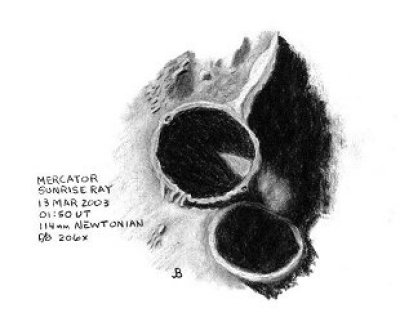
Observer: Jeff Burton Date/time of observation: 2003/03/13 01:50 UT Location: Paducah, KY, USA (37°02'41" N, 88°34'26" W) Altitude: 108.5 meters (356 feet) Bortle Scale: 8 - City Sky, Antoniadi Scale: III Instrument: 114mm f/8 Newtonian Magnification: 206x (11mm Tele Vue Plossl / 2.5x Barlow), 175x (13mm Tele Vue Plossl / 2.5x Barlow), 70x (13mm Tele Vue Plossl) Object: Mercator (Crater), Rukl Chart #53, Colongitude: 27°.9 Lunar Light Ray Coordinates: 29°.6 S, 26°.4 W.
Started observing the ray at 01:05 UT, at this time it appeared as a very small triangle of light on the western crater rim just south of craterlet Mercator C and directly across from craterlet Mercator B, which lies on the eastern rim. The ray began to lengthen and extend towards the center of the crater over the course of the next twenty minutes. By 01:35 UT, the ray appeared to extend about forty percent of the distance to the crater’s center, which was the maximum extent of the ray’s length. By 01:50 UT, the base of the ray has widened and the ray was an obvious wedge-shaped light on the floor of the crater at lower magnification (70x).
The base of the wedge shaped ray continued to widen and around 02:20 UT, the southern side of the crater began to fill with sunlight. Thirty minutes later, the crater floor was mostly bathed in bright sunlight.